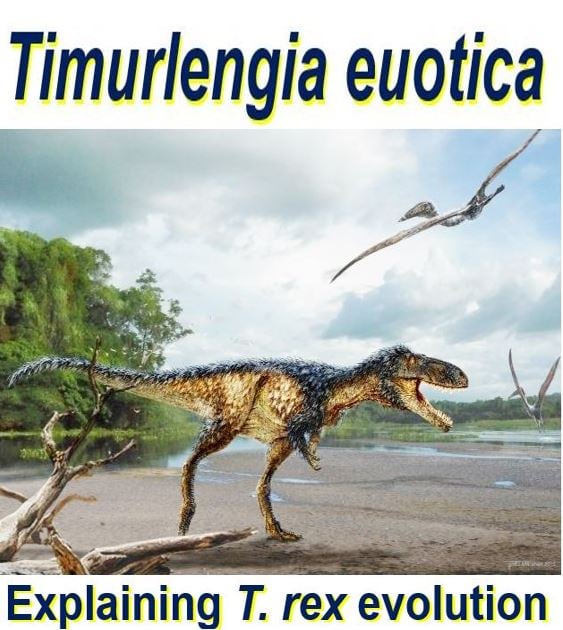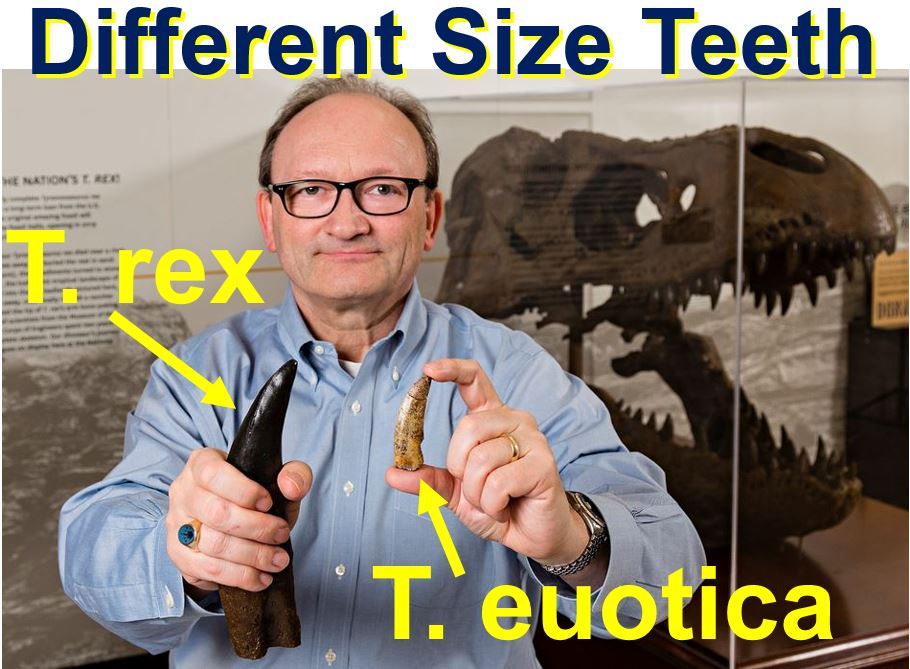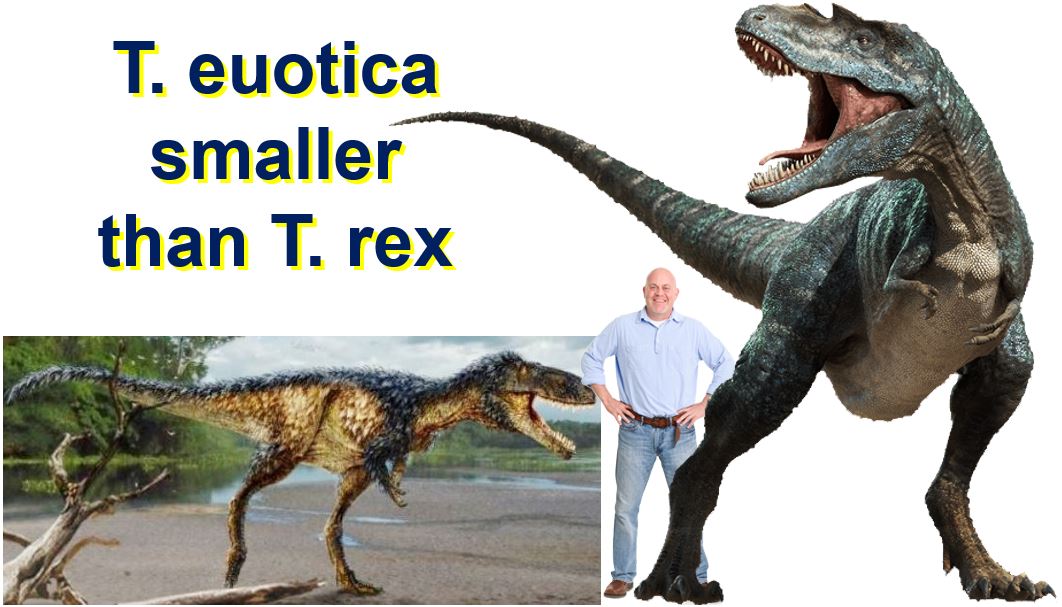Tyrannosaurus rex was small at first, no longer than 10 feet in fact, and lightly built – smaller than most modern horses. It was not until nearly 100 million years after they first appeared that they became the huge, fearsome creatures we are all familiar with, such as the one in the movie Jurassic Park.
T. rex first set foot on this Earth during the Jurassic as a slender and definitely unimposing creature, compared to the apex predators at the time. At the end of the Cretaceous, they had evolved rapidly into the kings of the food chain.
Scientists from the Smithsonian’s National Museum of Natural History , and colleagues from Russia and Scotland, explained in the academic journal Proceedings of the National Academy of Science (citation below) that nobody knew much about how this transition from junior to mega-predator occurred, that is, until now.
 An artist’s rendition of the new tyrannosaur – Timurlengia euotica – in its environment about 90 million years ago. Two flying reptiles (Azhdarcho longicollis) can be seen in the background. (Image: smithsonianscience.si.edu. Credit: Todd Marshall)
An artist’s rendition of the new tyrannosaur – Timurlengia euotica – in its environment about 90 million years ago. Two flying reptiles (Azhdarcho longicollis) can be seen in the background. (Image: smithsonianscience.si.edu. Credit: Todd Marshall)
New species explains T. rex’ evolution
Hans Sues, Chair of the Department of Paleobiology at the Museum, and colleagues say there was a hitherto unknown species – Timurlengia euotica – that lived approximately 90 million years ago. This creature fills in a twenty-million-year gap in the fossil record of T. rex during the early Cretaceous.
T. euotica was a nimble pursuit hunter with slender, blade-sharp teeth ideal for slicing through meat. This new species was not T. rex’ ancestor.
Co-author Dr. Sues says this new fossil helps explain how tyrannosaurs evolved so quickly towards the end of their 70-million-year existence on Earth.
Dr. Sues said:
“This fossil shows that tyrannosaurs developed their advanced head first. Timurlengia’s skull, though much smaller than that of T. rex, shows a sophisticated brain that would have led to keen eyesight, smell and hearing.”
 Reconstructed Timurlengia euotica skeleton with discovered fossilized bones, highlighted in red, and other bones remaining to be discovered inferred from other related species in white. (Image: smithsonianscience.si.edu. Copyright: Proceedings of the National Academy of Sciences)
Reconstructed Timurlengia euotica skeleton with discovered fossilized bones, highlighted in red, and other bones remaining to be discovered inferred from other related species in white. (Image: smithsonianscience.si.edu. Copyright: Proceedings of the National Academy of Sciences)
Tyrannosaurs evolved while other species became extinct
While the tyrannosaurs were developing their cognitive abilities and acute senses, other large predatory-dinosaurs were dying off – becoming extinct – opening up an opportunity to become top dog.
Dr. Sues and colleague Alexander Averianov from the Russian Academy of Sciences used fossils they had collected for the study. Over a 10-year period, they had gathered specimens during several expeditions to the Kyzylkum Desert in Uzbekistan.
Many familiar groups of dinosaur that existed during the Cretaceous have their roots in Central Asia – a number of them went on to flourish across North America.
T. euotica a new species
T. euotica’s remains were later examined and analyzed by Sues and a team of paleontologists led by Stephen Brusatte, who works at the University of Edinburgh in Scotland. They concluded that it was a new species.
After carrying out CT scans of Timurlengia’s brain case, they were able to reconstruct the creature’s brain and learn more about its senses.
 Hans Sues holding a cast of a Tyrannosaurus rex tooth for comparison with an actual tooth of the new tyrannosaur Timurlengia euotica. (Image: smithsonianscience.si.edu. Credit: James DiLoreto)
Hans Sues holding a cast of a Tyrannosaurus rex tooth for comparison with an actual tooth of the new tyrannosaur Timurlengia euotica. (Image: smithsonianscience.si.edu. Credit: James DiLoreto)
Dr. Sues said:
“Timurlengia answers the question of how later tyrannosaurs gain the advantages of size and acute senses. This new fossil shows a complex inner ear and nerves that fit with what we know about T. rex.”
“New discoveries like this show that there is still so much to be discovered about the history of dinosaurs. It’s not every day that you find a new tyrannosaur.”
 T. euotica was considerably smaller than T. rex was towards the end of its existence on Earth.
T. euotica was considerably smaller than T. rex was towards the end of its existence on Earth.
In an Abstract in the journal, the authors wrote:
“Tyrannosauroids apparently developed huge size rapidly during the latest Cretaceous, and their success in the top predator role may have been enabled by their brain and keen senses that first evolved at smaller body size.”
Citation: “New tyrannosaur from the mid-Cretaceous of Uzbekistan clarifies evolution of giant body sizes and advanced senses in tyrant dinosaurs,” Stephen L. Brusatte, Amy Muir, Alexander Averianov, Ian B. Butler and Hans-Dieter Sues. Proceedings of the National Academy of Science. 14 March, 2016. DOI: 10.1073/pnas.1600140113.
Video – T. euotica explains T. Rex evolution
